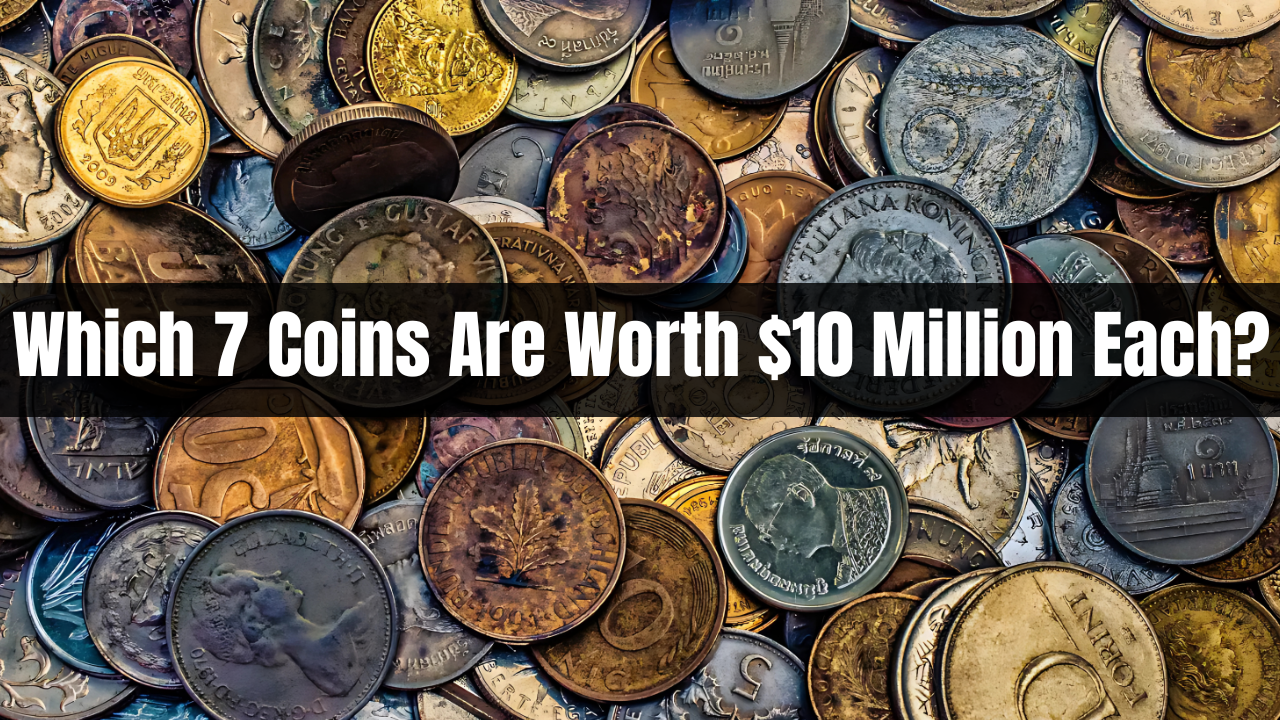Coin collecting, or numismatics, is a hobby that blends history, art, and the thrill of discovery. While most coins are worth only their face value, some are so rare and significant that they fetch millions at auction. These coins are not just currency; they are artifacts that tell stories of economic crises, minting errors, and diplomatic gestures. In this article, we explore the seven most valuable coins on Earth, each valued at $10 million or more, and provide practical tips on how to identify them. Whether you’re a seasoned collector or a curious beginner, understanding these treasures can spark excitement and potentially lead to a life-changing find.
1. 1933 Saint-Gaudens Double Eagle
Estimated Value: $19–22 million
Historical Significance: The 1933 Saint-Gaudens Double Eagle is one of the most iconic U.S. coins, designed by sculptor Augustus Saint-Gaudens. Minted during the Great Depression, it was never officially circulated due to President Franklin D. Roosevelt’s Executive Order 6102, which banned gold ownership and led to the melting of most of the 445,500 coins produced. A few survived, some illegally, making them extraordinarily rare. One sold for $18.9 million in 2021, the highest price ever for a U.S. coin.
How to Spot It:
-
Design: Features Lady Liberty striding forward with a torch and olive branch on the obverse, and a flying eagle on the reverse.
-
Date and Mint Mark: Look for “1933” with no mint mark (Philadelphia Mint).
-
Material: 90% gold, 10% copper, weighing 33.4 grams.
-
Condition: High-grade specimens (MS65 or above) are most valuable. Use a magnifying glass to check for wear or scratches.
-
Warning: Owning one may be legally complex, as most are considered government property. Consult a numismatist or legal expert if you suspect you have one.
2. 1794 Flowing Hair Silver Dollar
Estimated Value: $10–12 million
Historical Significance: The 1794 Flowing Hair Silver Dollar is considered the first silver dollar minted by the U.S. Mint, symbolizing the birth of American coinage. Only about 150–200 survive from the original 1,758 minted, with many melted down or lost. In 2013, a Specimen-66 (PCGS grade) sold for $10,016,875, setting a world record for a single coin sale at the time.
How to Spot It:
-
Design: Obverse shows Lady Liberty with flowing hair; reverse features an eagle surrounded by a wreath.
-
Date: Look for “1794” on the obverse.
-
Edge: Check for a lettered edge with “HUNDRED CENTS ONE DOLLAR OR UNIT.”
-
Material: 90% silver, 10% copper.
-
Tips: Examine for mint errors, such as off-center strikes, and verify authenticity with a grading service like PCGS or NGC to avoid counterfeits.
3. 1787 Brasher Doubloon
Estimated Value: $9–10 million
Historical Significance: Minted by goldsmith Ephraim Brasher before the U.S. Mint was established, the 1787 Brasher Doubloon is one of the first gold coins struck in the United States. Only seven are known to exist, with some bearing Brasher’s “EB” hallmark on the eagle’s breast or wing. One sold for $9.36 million in 2021. Its rarity and connection to early American history make it a numismatic legend.
How to Spot It:
-
Design: Obverse depicts a rising sun over mountains; reverse shows an eagle with a shield.
-
Hallmark: Look for “EB” stamped on the eagle’s breast or wing.
-
Material: Nearly pure gold, weighing about 26.6 grams.
-
Condition: High-grade examples are pristine with minimal wear.
-
Caution: Counterfeits are common. Verify with a professional numismatist.
4. 1804 Draped Bust Silver Dollar (Class I)
Estimated Value: $7.5–10 million
Historical Significance: Known as the “King of U.S. Coins,” the 1804 Draped Bust Silver Dollar was actually minted in the 1830s as diplomatic gifts for dignitaries, including the Sultan of Muscat and the King of Siam. Only 15 exist, with eight Class I specimens being the most valuable. One sold for $7.68 million in 2021.
How to Spot It:
-
Design: Obverse features Lady Liberty with a draped bust; reverse shows an eagle with a shield.
-
Date: Look for “1804” on the obverse.
-
Edge: Class I coins have a lettered edge.
-
Material: 90% silver, 10% copper.
-
Authentication: Use PCGS or NGC grading services, as fakes are prevalent.
5. 1913 Liberty Head Nickel
Estimated Value: $4.5–10 million
Historical Significance: The 1913 Liberty Head Nickel is shrouded in mystery, as it was never officially authorized by the U.S. Mint. Only five are known, possibly minted clandestinely by a Mint employee. One sold for $4.56 million in 2018, and their allure lies in their enigmatic origin.
How to Spot It:
-
Design: Obverse shows Lady Liberty; reverse features a Roman numeral “V” and a wreath.
-
Date: Check for “1913” on the obverse.
-
Material: 75% copper, 25% nickel.
-
Details: Look for sharp details in Liberty’s hair and the wreath.
-
Warning: Counterfeits are rampant. Professional grading is essential.
6. 1943 Copper Penny
Estimated Value: $10 million
Historical Significance: During World War II, the U.S. Mint switched to steel pennies to conserve copper, but a few 1943 pennies were mistakenly struck in copper. Only about 20 are known, with one selling for $10.7 million. This minting error makes it one of the most coveted U.S. coins.
How to Spot It:
-
Design: Standard Lincoln penny with “1943” on the obverse and a wheat stalk reverse.
-
Material: Test with a magnet; copper pennies are non-magnetic, unlike steel ones.
-
Weight: Copper pennies weigh 3.11 grams; steel pennies weigh 2.7 grams.
-
Condition: High-grade (MS64 or above) examples are most valuable.
-
Tip: Authenticate with a grading service to rule out counterfeits.
7. 2007 Queen Elizabeth II Million Dollar Coin
Estimated Value: $10 million
Historical Significance: Minted by the Royal Canadian Mint, this coin is a modern marvel, made of 100 kilograms of 99.999% pure gold with a face value of $1 million CAD. Only five were produced to promote the Mint’s gold bullion coins. One sold for $4 million in 2010, but its value has since risen to around $10 million due to gold prices and rarity.
How to Spot It:
-
Design: Features Queen Elizabeth II on the obverse; reverse shows a maple leaf.
-
Size: Massive, measuring 50 cm in diameter and 3 cm thick.
-
Material: Pure gold, weighing 100 kg.
-
Authentication: Verify with the Royal Canadian Mint or a numismatist.
-
Note: These coins are typically in private collections or museums, not circulation.
How to Identify Valuable Coins: Practical Tips
Spotting a $10 million coin in your pocket change is unlikely, but understanding key factors can help you identify valuable coins in collections or at auctions:
-
Check the Date and Mint Mark: Rare years (e.g., 1794, 1933) and specific mint marks (e.g., no mark for Philadelphia) are crucial. Use a magnifying glass to examine small details.
-
Look for Minting Errors: Double dies, wrong materials (like the 1943 Copper Penny), or missing mint marks increase value.
-
Assess Condition: Coins in pristine condition (graded MS65 or higher by PCGS or NGC) are worth more. Avoid cleaning coins, as it reduces value.
-
Research Rarity: Low mintage numbers (e.g., 24 for the 1894-S Barber Dime) drive value. Check mintage records online or in numismatic guides.
-
Authenticate: Counterfeits are common. Use reputable grading services like PCGS or NGC to verify authenticity.
-
Store Properly: Use acid-free holders, handle with gloves, and store in a dry environment to preserve value.
-
Consult Experts: If you suspect a valuable coin, contact a professional numismatist or auction house like Heritage Auctions or Stack’s Bowers.
Where to Find These Coins
These ultra-rare coins are unlikely to appear in circulation. They are typically found in:
-
Private Collections: Owned by wealthy collectors or investors.
-
Museums: The Smithsonian Institution houses specimens like the 1849 Double Eagle and 1822 Half Eagle.
-
Auctions: High-profile auctions by Heritage Auctions or Stack’s Bowers feature these coins.
-
Estate Sales or Heirlooms: Check old coin collections inherited from family members.
Avoiding Scams
The rare coin market attracts counterfeiters. To protect yourself:
-
Buy graded coins from reputable dealers.
-
Verify seller credentials.
-
Beware of “too good to be true” prices online.
-
Use authentication services for high-value coins.
In Summary
The seven coins listed above are the pinnacle of numismatic treasures, each worth $10 million or more due to their rarity, historical significance, and collector demand. While finding one in your change is a long shot, understanding their characteristics can enhance your appreciation for coin collecting and guide you in evaluating collections. Always research, authenticate, and consult experts to ensure you’re handling genuine treasures. The next million-dollar coin might be closer than you think—start checking those old jars and heirlooms today!

